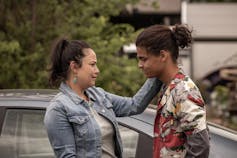Achi news desk-
Over the past 30 years, we have seen an exponential growth of indigenous media and indigenous media makers, especially here in Canada which has one of the largest repositories of indigenous media. This includes movies, TV shows, documentaries and even reality TV.
But the road to get here has not been easy.
This is because Indigenous filmmakers, producers and artists have had to navigate the complex and often unfriendly terrain of Canadian media organizations and media production companies.
But their discussions – and their struggles – over the past 30 years have helped make way for a new generation of Indigenous media makers who are now making shows and films on their own terms.
Crave/APTN
These Indigenous creators have more and more decision-making power – and more control over how their stories are told as well as the ability to subvert old colonial representations.
In a special episode of Don’t Call Me Tough, recorded on location with an audience in Vancouver at Iron Dog Books, we speak with Karrmen Crey, an expert on this new indigenous media world. Crey talks about the ways in which indigenous creators use humor combined with a sharp critique of pop culture to show how different the world looks when the decision-making power over how stories are told shifts and media makers native takes control.
Crey, who is a Stó:lō of Cheam First Nation, is an associate professor in the School of Communication at Simon Fraser University in Burnaby, BC Her research focuses on indigenously produced and created media in Canada and the media organizations which indigenous people have had to do. navigation to produce their work. Crey is an author Producing Sovereignty: The Rise of Canadian Indigenous Media.
Crey says:
I hope non-native people see [this new media] and not only register it as being funny, but register it exactly how sharp and clever it is. There is a lot of critical insight from those perspectives and I hope it spares them to be more receptive and thoughtful when looking at things from Indigenous perspectives.
Resources

(Shane Brown/FX)
Producing Sovereignty: The Rise of Canadian Indigenous Media (by Karrmen Crey, 2024)
Rutherford Falls (TV sitcom)
Order Dogs (TV programme)
“On-Screen Protocols and Pathways” (Report by the Native Screen Office, 2019)
Kanehsatake: 270 Years of Resistance (film by Alanis Obomsawin, NFB, 1993)
Shine Network
Listen and follow
You can listen to or follow Don’t Call Me Tough on Apple Podcasts (transcripts available), Spotify, YouTube or wherever you listen to your favorite podcasts.
We’d love to hear from you, including any ideas for future episodes.
Join the Conversation on Instagram, XLinkedIn and use #DontCallMeResilient.
Credits

(Catherine Zhu/The Conversation), Author provided (no reuse)
This episode was produced in front of a live audience at Iron Dog Books in Vancouver, in partnership with Simon Fraser University’s Faculty of Communication, Art and Technology and the Amplify Podcast Network. Simon Fraser student Natalie Dusek performed technological duties.
Ad blocking test (Why?)

Source link
The post From stereotypes to sovereignty: How Indigenous media makers are asserting narrative control – From stereotypes to … – The Conversation appeared first on Canadian News Media.

